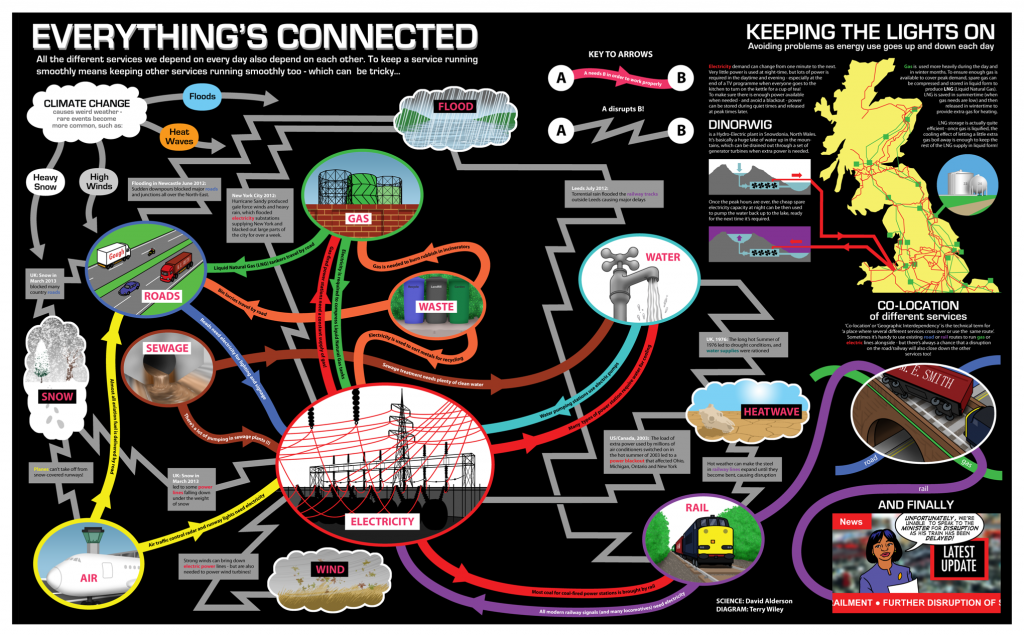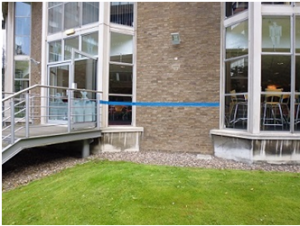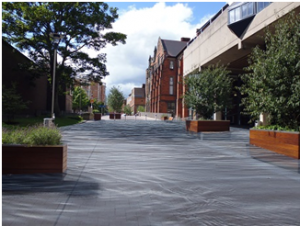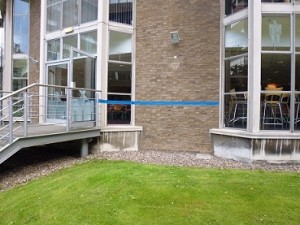Three fully funded PhD studentships are available within the Water Resources Engineering Group in the School of Civil Engineering and Geosciences at Newcastle University, sponsored by Science Agriculture and Engineering Faculty Doctoral Training Awards.
The Water Resources Engineering Group is a leading centre for research into climate and catchment modelling, and development of advanced hydroinformatics, risk analysis and decision support tools. These are used internationally to tackle the complexities of coupled technological, human and natural systems and enable practical responses to the challenges of intensifying global change.
Each Doctoral Training Award is for £20,000 per annum. This award is sufficient to cover home(UK)/EU fees and a contribution to an annual stipend (living expenses). Applications will be considered as they are received, until 18th August 2014 or sooner if the awards are made before this date.
Further details on each studentship are given below, including contact details for further information, and links to the Newcastle University website with details on how to apply.
Vulnerability of shallow groundwater and surface water resources used for irrigation in rural communities in Sub-Saharan Africa to climate variability and change.
Reference Code: CI701.
Contact: geoff.parkin@ncl.ac.uk.
Link: http://www.ncl.ac.uk/postgraduate/funding/search/list/ci701
There is abundant groundwater in Africa; more than 100 times the annual renewable freshwater resource and 20 times the amount of freshwater stored in lakes, but its productive use in sub-Saharan Africa (SSA) remains low. Globally, abstraction of groundwater increased tenfold between 1950 and 2000 and contributed significantly to growth in irrigation, particularly in Asia. Rapid expansion of groundwater use may also be about to occur in SSA, to support dry season irrigation used to enhance traditional rain-fed agriculture. Given the constraints of lack of technical and financial resources to drill into deeper aquifers, development of groundwater resources is easier to achieve in shallow aquifers. However, shallow aquifers are more vulnerable to climate variability, particularly to recurrent droughts or delays in the onset of wet season rainfall, due to their limited capacity as a groundwater store.
The research aims to carry out multi-scale assessments related to the impacts of climate variability and change across sub-Saharan Africa, to identify the key factors, particularly climatic but also including hydrogeological constraints, agricultural water potential demand, patterns of demand from crop choices, methods of irrigation, and land use within watershed management programmes, that control vulnerability of shallow groundwater resources used by rural communities for irrigation. Based on analysis of large-scale climatic patterns and water management practices, appropriate mathematical models of integrated groundwater-surface water systems will be developed at multiple scales, and used with statistical methods to assess vulnerability of shallow groundwater resources for a range of scenarios of climate and resource planning.
The use of long term climatic data takes places mainly at national and regional levels, influencing large scale policies. This PhD will include some visits to selected SSA countries for interaction with governance as well as technical institutions in order to understand the current and potential use of climatic data in decision-making. This contextual understanding will help to enhance the practical use of the research and to produce policy recommendations.
The PhD study is closely allied with an existing research project funded by NERC, ESRC and DfID, working in Ethiopia, Ghana and South Africa. A further proposal to extend this work over at least the period of the PhD study is being submitted. If successful, the student will be fully integrated into this research programme, which will offer further opportunities for in-depth field visits working with local communities.
We aim to recruit an ambitious numerate student who has the aptitude and interest for analysis of large datasets and use of advanced modelling techniques for climate and hydrological/hydrogeological assessments, together with an interest in application in a developing countries context. The student will be expected to liaise with our partners in Ethiopia and other African countries, in particular the International Water Management Institute and the Geological Survey of Ethiopia. Candidates would typically be expected to be educated in an undergraduate degree in a numerate discipline (e.g. engineering), with an MSc/MRes in a relevant applied discipline such as water resources management, or an undergraduate degree in environment or earth sciences with a relevant numerate MSc/MRes degree.
Will catchment scale afforestation for mitigating flooding significantly reduce water resource availability and productive farmland?
Reference Code: CI702
Contact: james.bathurst@newcastle.ac.uk
Link: http://www.ncl.ac.uk/postgraduate/funding/search/list/ci702
The 2013-14 winter floods in the UK have led to calls to afforest the uplands to reduce future flooding. However, the role of forests in flood reduction remains controversial. Further, the proportion of a catchment that would need to be forested to have a significant impact on downstream flooding, and the amount of farmland that would be correspondingly lost, have yet to be defined. Water resources could equally be reduced by the additional forest evapotranspiration. The study will therefore examine the hypothesis that catchment afforestation programmes can significantly reduce downstream flood hazard without significantly reducing water resource availability or productive farmland. Both headwater catchment plantation (affecting flood frequency and magnitude) and riparian plantation (to attenuate flood wave movement in the floodplain will be considered).
Study objectives include the impact that upstream afforestation can have downstream at the full catchment scale, the proportion of a catchment and the parts of a catchment that need to be afforested to have a significant downstream impact and the extrapolation of the results to a potential full UK programme. An integrated field and modelling approach will be followed, in which the field study ensures a foundation on firm experimental evidence while the modelling provides the means to extrapolate from the necessarily limited field data and to generalise applicability. The effects of afforesting headwater catchments will be investigated using Newcastle University’s leading physically-based catchment modelling system SHETRAN. The relevant field evidence will come from an existing paired grassland/forest catchment experiment in the Irthing catchment (Cumbria) headwaters while the full catchment will form the basis for simulations investigating the scale and spatial distribution issues. The impact of riparian forest will be modelled using a powerful new hydrodynamic modelling framework, developed at Newcastle University, that fully exploits modern graphics and central processing units. The relevant field evidence will come from existing experimental studies in Northumberland into the use of instream large wood debris structures and riparian plantation to attenuate flood wave movement. A recently developed framework for applying SHETRAN at the UK scale will provide the basis for simulating the impact of catchment afforestation on flood response at the national scale. An important output will be benefit in flood reduction as a function of the area and location of land required to be afforested to achieve that benefit, compared with the associated reduction in water resource availability and loss of farmland. Stakeholder involvement will ensure focus on practical and applied outcomes and provide a pathway for achieving impact. The study is highly relevant to the social issue of flooding while also providing an opportunity to examine in detail the scientific controversy over the impact of forests on floods within the context of a potential large-scale application.
Applicants should have a 1st class or high 2.i first degree or a MSc with at least a high merit pass (65+). Relevant degrees include environmental science, geography, engineering and mathematics. Applicants should be willing to carry out field work in remote areas of northern England in all weathers; for this it would be helpful to have an appropriate driving licence. They should be numerate, have an aptitude for computer modelling and be fluent in English, including writing.
Attribution of climate risks in urban areas for the design of adaptation pathways
Reference Code: CI700
Contact: richard.dawson@newcastle.ac.uk
Link: http://www.ncl.ac.uk/postgraduate/funding/search/list/ci700
Climate related risks are usually a function of multiple weather, socio-economic and engineering factors. This is particularly acute in urban areas where these three dimensions are tightly coupled and highly dynamic. Attribution of risk, decomposes its constituent elements to enable decision-makers to better target investment to manage risk. Methods of attribution are emerging for global scale analysis, providing useful information for global greenhouse gas mitigation. But these methods are not suited to local scale attribution of risk, and prioritisation of investment in adaptation strategies to reduce climate related risks. This PhD will address this challenge through development of a range of analytical approaches to decomposing the constituent factors of climate risk at the urban scale.
The ideal candidate would be:
- from an engineering, mathematical or physical science background,
- proficient in statistics, computational analysis and modelling,
- knowledge of climate change and adaptation issues,
- able to communicate with urban planners and infrastructure owner/operators, and,
- capable of writing up their work for academic and stakeholder audiences.






